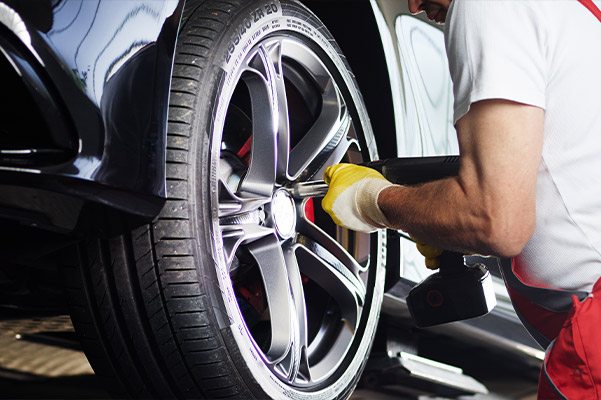Open Performance: Professional GMC Tire Service at Morris Tires
Wiki Article
Tire Solution: The Impact of Weather Condition Problems
When it comes to guaranteeing optimum performance and safety on the road, recognizing the impact of weather condition problems on tire solution is essential. GMC Tire Service. In this conversation, we will certainly discover the complex connection in between weather conditions and tire solution, shedding light on the relevance of weather-specific tire upkeep techniques and considerations.Warmth and Tire Efficiency
When revealed to high temperature levels, tires experience adjustments in efficiency that can dramatically affect automobile safety and security and handling. The warmth generated from long term driving or heat problems triggers the tire rubber to soften, resulting in decreased walk life and raised wear. As the rubber becomes softer, the tire's hold when driving reduces, impacting braking ranges and total grip. In extreme cases, extreme warmth can also trigger tire blowouts, presenting a severe security danger to the lorry and its owners.
Cold Climate Effects
Winter conditions can have a significant impact on tire efficiency and security. As temperatures decrease, tire rubber can set, bring about reduced traction on icy or snow-covered roadways. In winter, tires might additionally lose atmospheric pressure much more rapidly, which can affect managing and fuel performance. Additionally, cool temperatures can trigger tire sidewalls to tense, boosting the danger of damages from splits or other roadway hazards.To mitigate the impacts of chilly weather condition on tires, it is vital to regularly inspect tire pressure and inflate them to the manufacturer's recommended degrees. Utilizing winter or all-season tires developed for winter conditions can additionally boost traction and hold on icy or snowy roads. Proper tire maintenance, consisting of routine assessments for wear and damages, comes to be a lot more essential during colder months to ensure optimal performance and safety and security.
Rainy Issues Effect
Throughout stormy conditions, tire efficiency and security can be substantially affected by the damp roadway surface areas and lowered presence. The step pattern of tires plays an essential function in maintaining traction on wet roads. Tires with worn-out treads are much more susceptible to hydroplaning, where a layer of water accumulates in between the tire and the roadway surface, bring about loss of traction. To battle this, drivers need to consistently examine their tires for appropriate step deepness and consider buying tires specifically created for damp conditions.In addition, stormy weather can also lower visibility, making it challenging for drivers to see the roadway ahead plainly (GMC Tire Service). In such conditions, it is important to our website adjust driving speeds appropriately and keep a safe adhering to distance to permit abrupt stops. Effectively inflated tires can also help in keeping control on wet roadways by providing far better handling and grip
Snow and Tire Safety And Security
Snow-covered roadways pose special challenges for vehicle drivers, highlighting the importance of appropriate tire choice and maintenance. When driving in snowy conditions, having the right tires can make a substantial distinction in security and efficiency. Winter season tires are made with special rubber substances and tread patterns to supply better traction on snow and ice compared to all-season tires. The much deeper treads and sipes of winter months tires help grasp the roadway better, lowering the danger of sliding and gliding.
In addition, drivers should consider setting up tire chains in severe snowy problems. Tire chains give additional traction by gripping the snow and ice, enhancing stability and control. It is important to follow producer instructions when installing and using tire chains to stop damage to the tires and car (GMC Tire Service). By picking the best tires, maintaining correct rising cost of living, and thinking about additional grip help like tire chains, motorists can improve their security when navigating snow-covered roads.
Weather-Related Tire Upkeep
When encountered with various climate conditions, appropriate tire upkeep becomes an important aspect of car safety and efficiency. Weather-related tire upkeep encompasses an array of practices aimed at making certain optimal tire function and longevity in different weather situations. One vital element of weather-related tire maintenance is tire pressure guideline. Fluctuating temperatures can trigger tire pressure to vary, influencing traction and fuel efficiency. Regularly changing and examining tire stress according to maker recommendations is vital for risk-free driving in transforming climate condition. In addition, tire walk depth plays a considerable duty in managing various climate elements. Tires with appropriate walk deepness offer her response better hold on damp or icy roads, minimizing the danger of hydroplaning or skidding. Examining tire tread frequently and changing tires when walk wear reaches a specific depth is essential for keeping grip and stability in adverse weather condition. By focusing on weather-related tire upkeep, chauffeurs can enhance safety and security, boost vehicle efficiency, and extend the life-span of their tires.
Final Thought
Finally, weather condition problems have a significant influence on tire efficiency and security. From heat impacting tire stress and put on to winter reducing grip, it is necessary to think about the weather condition when preserving and making use of tires. Stormy conditions can lower grasp and lead to hydroplaning, while snow can enhance the risk of accidents if tires are not effectively equipped. Weather-related tire upkeep is crucial in making sure optimum efficiency and safety on the right here roads.In this discussion, we will certainly discover the intricate partnership between weather conditions and tire solution, losing light on the value of weather-specific tire upkeep techniques and considerations.

Report this wiki page